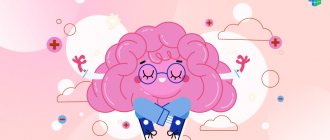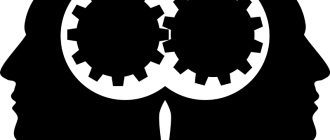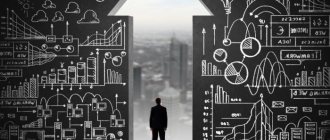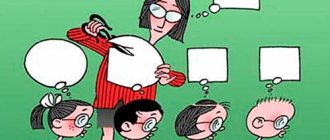Updated July 20, 2021 687 Author: Dmitry Petrov
Hello, dear readers of the KtoNaNovenkogo.ru blog. We can perceive objects: their color, shape, size. Build a logical chain between them. Imagine in your head with your eyes closed. And also think about absolutely abstract things and make plans for the future.
All this is provided by our thinking. It is limitless in its functions and manifestations. To date, all processes have not been fully studied. But we will still tell you something interesting here.
Thinking is...
Thinking is a cognitive process through which the reality around us is reflected, a way of interacting with the outside world. Often thinking is associated with a task and problem that needs to be solved.
It has two important features:
- This is mediation . A person first perceives information through the senses. Through these sensations the idea of objects is formed. You reach some properties through others, and based on facts you can think about broader things.
- The second is generality , which is related to the first feature. All properties of objects are combined with each other. And a person connects them while thinking like a puzzle, and thus the overall picture of the world appears.
As they said earlier, thinking actively works when resolving a situation. The process of gradual development of thinking can be described in 4 stages:
- Awareness of the presence of a problem after analyzing information over a period of time.
- Formation of hypotheses and search for solutions.
- Testing hypotheses.
- Solving a problem situation.
Rational cognition
Rational knowledge is carried out by reason. It is unique to humans and is a rather complex way of reflecting reality.
Basic mechanisms of rational cognition: comparison, assimilation, generalization, distraction.
Forms of rational knowledge:
- A concept is a thought that asserts the general and essential properties of an object.
- A judgment is a thought that affirms or denies something about an object.
- Inference (conclusion) is the mental connection of several judgments and the derivation of a new judgment from them.
An example of an inference: if a > b and b > c , then a > c .
Types of inferences:
- Inductive inference - from the particular to the general.
- Deductive reasoning - from the general to the specific.
- The one that is obtained by analogy.
Thought processes
To solve a problem and reveal the essence of a phenomenon/situation, thought processes are activated. Depending on the purpose, one or another type of information processing will be used.
Analysis and synthesis
Synthesis is the combination of details, properties and actions into a holistic picture, depending on the relationships between these parts.
Analysis is the reverse process of synthesis, which consists of decomposing the whole into smaller bricks.
People can do this practically by connecting their thinking. For example, in kindergarten, at work. A clear and simple example would be the same constructor or the construction of a house.
This can also happen exclusively logically in the head, analyzing the general situation into individual important nuances. For example, revealing different sides of a new acquaintance, although before this you had a presumptive image of his personality.
Comparison
Comparison is the establishment of differences and similarities between objects and phenomena.
At the heart of this process is analysis. Because first you need to identify several main features in order to compare them later.
The comparison can be superficial or deep depending on the time spent and ability to analyze the details. And also one-sided and multilateral - did a person need to pay attention to only one aspect, or was their combination important?
Specification
Concretization is clarification, detailing the properties and descriptions of an object or situation. When the ray of attention is completely aimed at one point, and thinking works only in this direction.
Abstraction
Abstraction is the opposite of the above concept. A person is distracted from all the features of an object in order to consider one characteristic in more detail. So that others do not interfere or influence perception. It is through this process that scientists work on their theories and inventions.
Methods of cognition
All methods of knowledge can be divided into two large groups: empirical and theoretical.
Empirical ones are built on the observation of certain phenomena. Theoretical ones are based on the analysis of available information and rational reasoning.
Empirical methods:
- Observation is the study of an object in its natural environment without influencing ongoing processes.
- Measurement is obtaining the numerical characteristics of an observed object by comparing its properties with standard values.
- An experiment is the deliberate creation of special conditions and further study of an object that is placed under these conditions.
- Comparison is a comparison of the properties of the object being studied with the properties of other objects.
Theoretical methods:
- Analysis - dividing an object into components and studying it in detail.
- Synthesis is the reconstruction of a complete picture from individual parts.
- Comparison - comparison of several objects, identifying identical and different properties.
- Classification is the grouping of studied objects into groups based on the presence of identical properties.
- Specification is a deeper study of certain properties.
- Abstraction is the study of a subject from a new angle (with an emphasis on some properties and ignoring others).
- Systematization is the combination of accumulated knowledge into a system in which relationships and patterns are indicated.
- Induction is inference that is directed from the particular to the general.
- Deduction is inferences that are directed from the general to the specific.
- Idealization is the creation of an image of a fictional object with ideal properties and using it as a special example.
- Modeling is the creation of a model of an object for a detailed study of its properties, which is impossible on a real object.
Cognition has two levels (stages): sensory and rational. Let's consider each of them separately.
Types of thinking in psychology
Back in school we were taught what types of thinking exist. We are not sure that this information has been preserved in full format, so let us remind you.
Visually effective
This type of thought process relies directly on the perception of objects, so the baby’s development begins with it. In another way it can be called concrete or practical . Aimed at solving technical problems.
In this type of thinking, the mental and practical parts interact. The important aspects here :
- observation and special attention to detail;
- use of work schemes;
- the ability to quickly move from thought to action.
Visual-figurative thinking
Here the images and ideas of a person, his imagination, already appear on the stage. The information that a person has perceived from the world around him is embodied in various images in his head.
During such thinking, completely different pictures may appear that have not been seen in reality before. Creative ideas are generated. This type of thought process is well developed in creative individuals and inventors.
Verbal-logical
Consists of concepts and logical connections between them. As a rule, it is more necessary to establish connections between incidents, objects, and people.
Otherwise called abstract . Because this includes the ability to imagine things that cannot be seen or touched in reality. For example, love or happiness.
All types of thinking are interconnected and are often equally developed in humans. Depending on the situation, the most suitable one is activated to solve the problem.
Definition of cognition
What is cognition ? This is a set of processes and methods through which you can gain knowledge about the world around you.
This is a broad concept that covers both the natural desire to find a logical explanation for the processes occurring around us, and artificially created methods for obtaining and accumulating knowledge.
The desire to explain every phenomenon of the surrounding world is the main factor in the emergence and development of human civilization.
Structure of cognition:
- The subject is the one who performs actions aimed at obtaining knowledge. For example, you are reading this material to learn the types of cognition and their characteristics. It turns out that you are a subject of cognitive activity.
- An object is what the subject’s activity is aimed at. For example, now the object of your cognitive activity is the concept of knowledge and its types.
- Motives - why we do something. There are two types of motives:
- Practical motives push to possess knowledge in order to use it to improve the quality of life (studying at an institute gives a profession that feeds).
Theoretical motives are based on obtaining pleasure from the process of cognition itself (read a book and expand the library of your knowledge).
- The purpose of cognitive activity is to obtain true, reliable knowledge about the world, to understand how reality actually works.
- The result is the very knowledge about an object or phenomenon. Sometimes the result occurs unconsciously, for example, if a child plays with a clay mug and breaks it, he will immediately understand that the clay is fragile and will handle the dishes more carefully.
Now we will find out what methods of cognition exist, and then we will move on to forms.
Quality thinking
Since thinking is one of the mental processes, it is as individual as character or temperament.
It can be characterized by the following criteria :
- Breadth – the ability to cover a wide range of issues, knowledge in different industries, and the ability to think creatively.
- Depth is the ability to foresee a situation in advance after analysis, the ability to penetrate to the essence.
- Flexibility - quickly change your strategy depending on how circumstances change. Using different types of tactics, as well as the ability to find new solutions.
- Independence is the ability to set the right goal yourself and find an approach to it. This is also where creativity and creative potential comes into play.
- Originality is the ability to produce new ideas that differ from the generally accepted ones.
- Initiative – a constant desire to bring something of your own; solve the problem if you have not yet been made a performer.
Natural planning model
David Allen's book “Getting Things Done” describes the natural planning model. To perform almost any action, your brain takes five steps:
- defines purpose and principles;
- visualizes the result;
- brainstorms;
- carries out the organization;
- defines the following specific actions.
These five phases of project planning occur naturally no matter what you do during the day. This is how you create something new, be it a dinner at a restaurant, a nice evening, a new product or a new company (read more about the five steps).
Critical thinking
Another important characteristic is criticality. It is with it that a person can objectively evaluate the world around him.
Critical thinking is a system of judgment for analyzing everything around, on the basis of which conclusions are drawn. Based on logic and cause-and-effect relationships, one can determine what is truly true.
Some practical examples of use:
- Effective problem solving at home and at work. Achieving the goal faster and more accurately.
- Recognizing real arguments from a set of words when communicating with others.
- Using as evidence the opinions of truly knowledgeable persons (experts). The ability to competently use facts to prove your point of view and lead a discussion.
- Identify key ideas in books and lectures.
- The ability to understand someone else's worldview.
What can a person with well-developed critical thinking do:
- be convincing;
- listen carefully and study information;
- analyze and criticize;
- express yourself competently;
- easily justify your point of view;
- make decisions quickly in new situations;
- interpret effectively;
- reason logically;
- form and voice your own judgments.
Divergent and convergent thinking
These complex names are used, as a rule, to describe work in a team. But this can also concern thoughts in the head of one person. Now we will explain everything in accessible language.
Divergent thinking is the discovery and expression of new ideas without the opportunity to criticize and discuss. This type of thought process allows you not to stop your imagination and produce whole streams of sometimes good solutions to problems, sometimes complete nonsense.
Accordingly, convergent thinking is the assessment and analysis of ideas in a brainstorm. During such rational selection, many decisions are immediately discarded. And others, in a repeated circle, succumb to critical thinking.
In order to find a way out of the situation quickly and effectively, you should not go to extremes. Because you can either generate a huge pile of unrealistic ideas or get stuck in an analytical stupor, afraid to assume anything.
Variety of activities (grade 10)
There are four main types of activities, each with unique characteristics:
Types of activity | |||
| A game | Teaching | Work | Communication |
| The goal is the activity itself, relaxation and moral satisfaction from the process. - does not involve the creation of a material product; - occurs in a conditional situation; - substitute items are used in the process of activity; - promotes personal development. | The goal is to acquire new knowledge. Forms of teaching: - Organized (in educational institutions). — Unorganized (in other types of activities). - Self-education. | The goal is to achieve a practical result. Characteristic features: — Expediency; — Focus on a specific result; — The need for knowledge and skills; — Transformation of the external environment. | The goal is to exchange activities, experience, and information. Communication is one of the necessary conditions for the development of society; in the process of communication, social experience is transmitted, changes in interacting subjects occur, personality is formed and its socialization occurs. |











